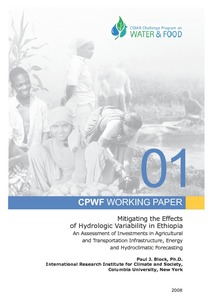Resource information
Ethiopia is at a critical crossroads with a burgeoning population, a severely depressed national economy, insufficient agricultural production, and a minimal number of devel- oped energy sources. This study assesses how investment in and management of water resources, together with related policy reforms, may mitigate the negative effects of hydrologic variability on the performance and structure of the Ethiopian economy. This is accomplished by identifying interventions both aimed at managing hydrologic variabil- ity, and at decreasing the vulnerability of the economy to potential shocks. The areas
of focus include increased infrastructure for agricultural irrigation and roads, large-scale hydropower generation, and a precipitation forecast model.
A dynamic climate agro-economic model of Ethiopia is utilized to assess irrigation and road construction investment strategies in comparison to a baseline scenario over a 12-year time horizon. Although both investments create positive economic boosts, the irrigation investment, on average, slightly outperforms the road investment, producing an average gdP growth rate of 0.95% versus 0.75% over the baseline scenario, along with lower associated poverty and malnutrition rates. The benefit-cost (b-c) ratios for the projects also favor the irrigation investment.
The upper Blue nile basin harbors considerable untapped potential for irrigation and large-scale hydropower development and expansion. An integrated model is employed to assess potential conditions based on hydrologic variability and streamflow policies. The model indicates that large-scale development typically produces b-c ratios from 1.6- 2.1 under historical climate regimes for the projects specified. Climate change scenar- ios indicate potential for small b-c increases, but reflect possible significant decreases. stochastic modeling of scenarios representing a doubling of the historical frequency of El nin?o events indicates b-c ratios as low as 1.0 due to a lack of timely water. An evaluation of expected energy growth rates reinforces the need for significant economic planning and the necessity of securing energy trade contracts prior to extensive devel- opment. A Ramsey growth model for energy development specifies project multipliers on total gdP over the 100-year simulation ranging from 1.7-5.2, for various climatologic conditions.
The Blue nile basin also holds possibility for improvement in rain-fed agricultural pro- duction through precipitation forecasting. one-season lead predictors for forecasting of the Kiremt season precipitation are identified from the large scale ocean-atmosphere- land system. This forecast is of tremendous value, giving farmers crucial indication
of potential future climatic conditions, and is a solid improvement over climatology, as currently utilized by the Ethiopian national Meteorological Institute. Using crop yield potential from the 1961-2000 period and general seed costs, farmers basing cropping decisions on the forecast model, in lieu of climatology, would have experienced superior net incomes.


